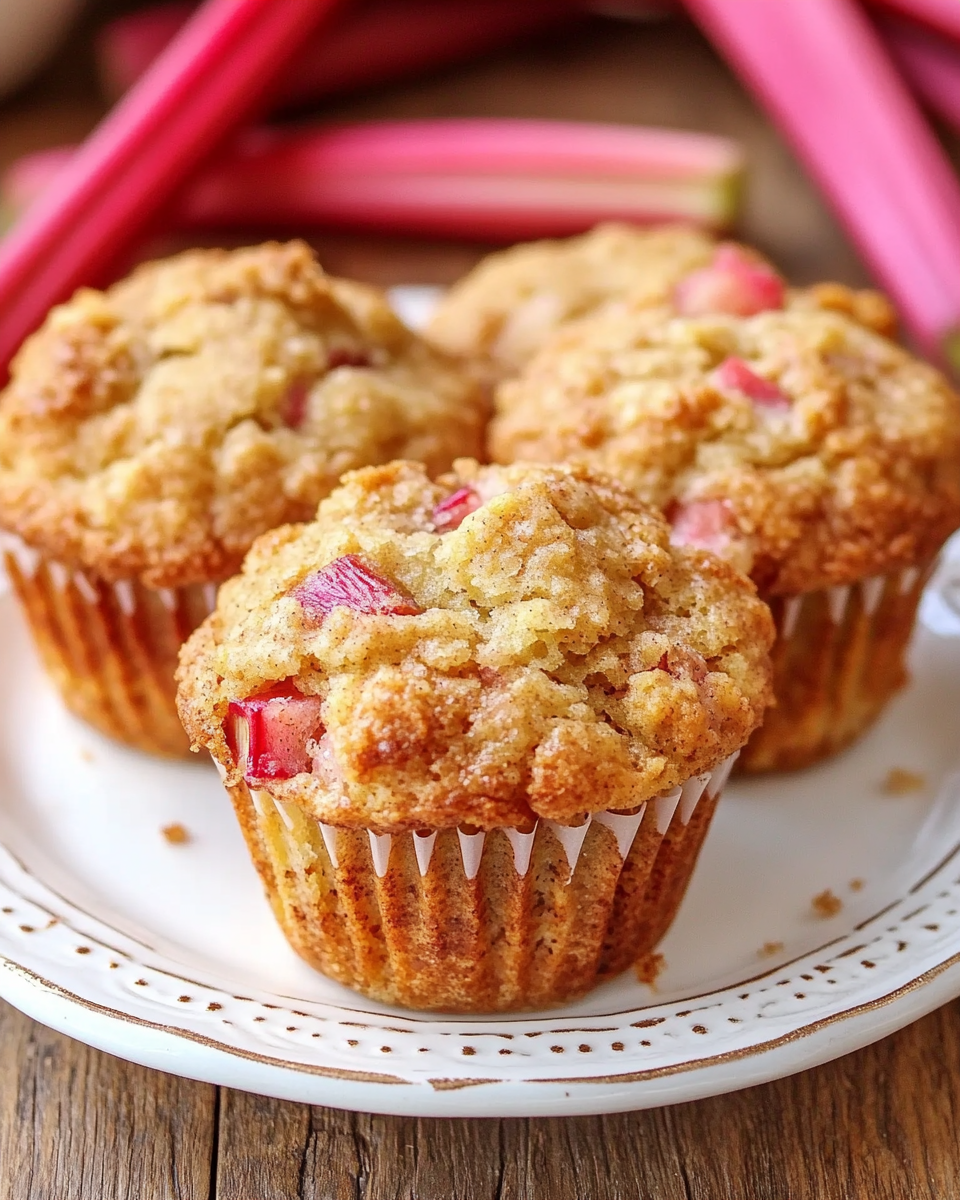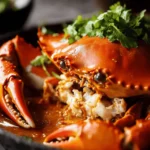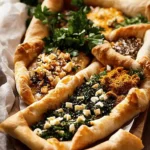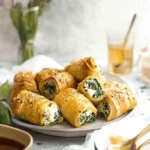These cinnamon-topped rhubarb muffins are a delightful blend of tart rhubarb and sweet cinnamon, creating a perfect balance of flavors. Soft, moist, and bursting with fresh fruit, they make a wonderful breakfast treat or afternoon snack that’s sure to please the whole family.
FULL RECIPE
Ingredients
- 2 cups fresh rhubarb, chopped
- 2 cups all-purpose flour
- 1 cup granulated sugar
- 1/2 cup brown sugar
- 2 teaspoons baking powder
- 1/2 teaspoon baking soda
- 1/2 teaspoon salt
- 1 teaspoon ground cinnamon
- 1/2 cup unsalted butter, melted and cooled
- 2 large eggs
- 1 teaspoon vanilla extract
- 1/2 cup buttermilk
- Additional cinnamon and sugar mixture for topping (about 2 tablespoons sugar mixed with 1 teaspoon cinnamon)
Directions
- Preheat oven to 375°F (190°C). Line a muffin tin with paper liners or grease well.
- In a large bowl, whisk together flour, granulated sugar, brown sugar, baking powder, baking soda, salt, and cinnamon.
- In another bowl, combine melted butter, eggs, vanilla extract, and buttermilk until smooth.
- Add the wet ingredients to the dry ingredients and stir just until combined. Do not overmix.
- Gently fold in the chopped rhubarb.
- Divide the batter evenly among the muffin cups, filling about 2/3 full.
- Sprinkle the cinnamon-sugar mixture evenly over the tops of the muffins.
- Bake for 20-25 minutes, or until a toothpick inserted into the center comes out clean.
- Let muffins cool in the pan for 5 minutes, then transfer to a wire rack to cool completely.
Nutritional Information
- Calories: 210 per muffin
- Total Fat: 8g
- Saturated Fat: 5g
- Cholesterol: 45mg
- Sodium: 220mg
- Carbohydrates: 32g
- Fiber: 1g
- Sugars: 18g
- Protein: 3g
History of Rhubarb in Baking
Rhubarb has a long-standing history in baking, often cherished for its tart flavor that pairs beautifully with sweet ingredients. Originating from Asia, rhubarb found its way into European kitchens in the 18th century and quickly became a popular component in pies, crumbles, and muffins. Its use in baked goods reflects a balance between tartness and sweetness that appeals to many palates.
Why Rhubarb Works Well in Muffins
Rhubarb’s natural acidity contrasts nicely with the sweetness of muffin batter. This balance prevents the muffins from being overly sugary and adds a fresh, tangy note that enhances the overall flavor. Its fibrous texture also contributes to a pleasant bite without making the muffins dense.
The Role of Cinnamon in This Recipe
Cinnamon adds warmth and depth to the muffins, complementing the tartness of rhubarb. The cinnamon topping creates a slight crunch and aromatic sweetness on the muffin surface, making each bite more flavorful and inviting.
Choosing Fresh vs. Frozen Rhubarb
While fresh rhubarb is ideal for its vibrant flavor and texture, frozen rhubarb can be used when fresh is out of season. Frozen rhubarb should be thawed and drained well to avoid excess moisture that can affect the muffin’s texture.
Tips for Preparing Rhubarb
Cutting rhubarb into uniform pieces ensures even distribution throughout the muffins. Removing the leaves, which are toxic, is crucial. Washing and drying rhubarb thoroughly helps maintain its natural freshness and prevents added moisture.
Baking Powder and Baking Soda Combination
The combination of baking powder and baking soda in this recipe ensures proper rising and a tender crumb. Baking powder provides an initial lift, while baking soda reacts with acidic ingredients like rhubarb and buttermilk for additional leavening.
The Importance of Buttermilk
Buttermilk adds moisture and a slight tanginess to the muffins, enhancing flavor and tenderness. Its acidity reacts with baking soda to help the muffins rise properly, creating a light and fluffy texture.
Butter vs. Oil in Muffins
Using melted butter in this recipe provides rich flavor and moistness, while also helping the muffins brown nicely. Butter’s solid fats contribute to a more tender crumb compared to oil, which may create a denser texture.
Balancing Sweetness and Tartness
The blend of granulated sugar and brown sugar balances the tart rhubarb by adding both sweetness and a hint of molasses flavor. This dual sugar approach adds complexity to the muffins’ taste and ensures they aren’t too sweet or too sour.
Cinnamon-Sugar Topping Technique
Sprinkling a cinnamon-sugar mixture on top before baking creates a delightful crust that contrasts with the soft interior. This finishing touch adds texture and an inviting aroma, enhancing the overall eating experience.
How to Avoid Overmixing the Batter
Overmixing develops gluten in the flour, which can lead to tough muffins. Mixing just until ingredients are combined keeps the muffins tender and light. Gently folding in rhubarb pieces preserves their shape and prevents the batter from becoming overly dense.
Adjusting Baking Time for Different Ovens
Oven temperatures vary, so checking muffins a few minutes before the suggested baking time is wise. Muffins are done when a toothpick inserted in the center comes out clean or with a few moist crumbs. Avoid opening the oven frequently to maintain consistent heat.
Storage Tips for Rhubarb Muffins
Store muffins in an airtight container at room temperature for up to two days to keep them fresh. For longer storage, freeze them wrapped individually and thaw at room temperature. Reheating gently in the oven or microwave refreshes their softness.
Serving Suggestions
Rhubarb muffins pair wonderfully with butter, cream cheese, or a light drizzle of honey. They are delicious alongside a cup of tea or coffee and make an excellent snack or light breakfast option.
Nutritional Benefits of Rhubarb
Rhubarb is low in calories and rich in fiber, vitamin K, and antioxidants. Including it in muffins adds a nutritional boost while keeping the treat relatively healthy compared to other baked goods.
Variations to Try
Adding nuts like walnuts or pecans can introduce a crunchy texture. Swapping cinnamon for nutmeg or ginger offers different spice profiles. Mixing in berries with rhubarb creates a fruit medley that is both colorful and flavorful.
Allergy Considerations
This recipe contains common allergens like wheat, eggs, and dairy. Substitutions such as gluten-free flour, flax eggs, or plant-based milk can be used to accommodate dietary restrictions, though texture and flavor may vary slightly.
Seasonal Availability of Rhubarb
Rhubarb is typically in season from spring to early summer, making it a perfect ingredient for fresh, seasonal baking. Using rhubarb during its peak season ensures the best flavor and texture in your muffins.
How to Make This Recipe Your Own
Adjust sweetness, spice, and fruit quantity to suit your taste. Experimenting with different toppings or adding glaze can personalize these muffins and keep the recipe exciting for repeat baking.
Advertisement
Common Mistakes to Avoid
Using rhubarb that is too large or not evenly chopped can lead to uneven baking. Adding too much moisture or overmixing the batter can cause dense muffins. Ensuring proper oven temperature and timing is key to perfect results.
Conclusion
Cinnamon-topped rhubarb muffins are a timeless treat that blends tart and sweet flavors with comforting spices. With attention to ingredient preparation and baking techniques, these muffins deliver a tender crumb and a flavorful punch. Their versatility allows for many variations, and their seasonal nature makes them a special delight in spring and early summer. Whether served for breakfast, dessert, or a snack, they offer a satisfying and wholesome option that appeals to all ages and tastes. This recipe showcases how simple ingredients can come together to create a memorable and delicious homemade muffin experience.






